
13 minute read
Burning Wood
Northern Grounds Coffee and wine bar. Espresso, single-origin coffee roasted on site, tea, chai, and mocha. More than 50 by-the-glass fine wines and a wine-of-the-month special, plus craft beers and specialty cocktails on tap. Check the calendar for wine tasting evenings. Register @thenortherngrounds.com. Charcuterie, fresh-baked breads and pastries, smoothies, soup and sandwiches. 2 W. Sheridan St.. 365-6162 $5-8 V #63
The Rusty Cup at Silver Rapids Lodge. Right on the snowmobile trail. Try the uniqueto-Ely menu items like Northern Frickles–deep fried pickles with spicy sauce, and Tater Kegs–super-size tots with bacon and cheddar. Plenty of sandwiches, salads, and entrees to choose from including their house-made meatloaf , walleye, and prime rib specials. Full bar and specialty cocktails with lots of mules. 459 Kawishiwi Trail, 365-4877, $15-28, C V #9
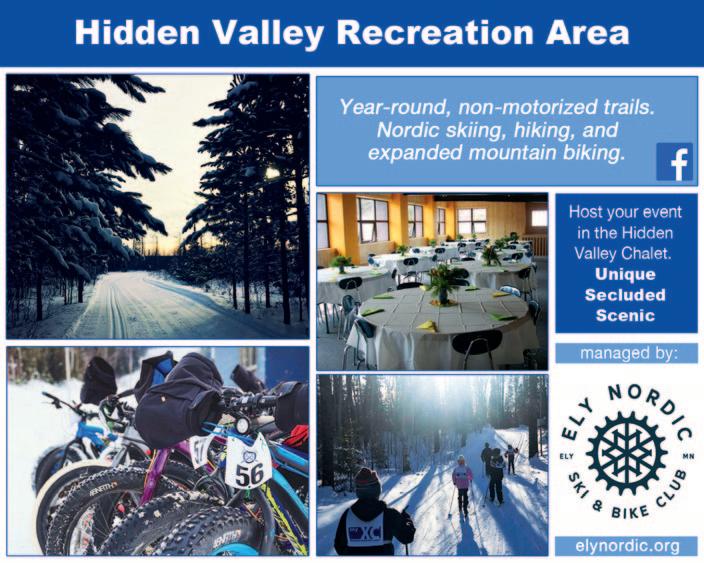
Dairy Queen - 1441 E. Sheridan (closed for a bit for the holidays) Log Cabin Coffee - 1340 E. Sheridan Subway -1520 E Sheridan Zup’s Deli - 1500 E. Sheridan
© Juliann Grahn, taken in her backyard
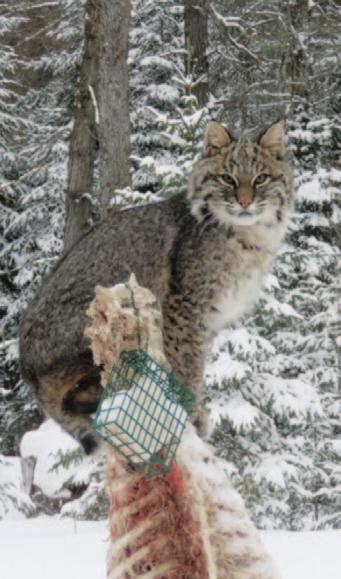
Ely’s Bars
Peanuts, Pizza, & More
Catz Billiards - 29 E. Chapman Dee’s Bar - 17 E. Sheridan Ely Steak House - 216 E. Sheridan Antlers Lounge- 400 N. Pioneer Kwazy Wabbit - 11 N. Central Samz Place - 1203 Old Winton Rd. Silver Rapids - 450 Kawishiwi Tr. Zaverl’s Bar - 509 E. Sheridan
Domino’s Pizza, wings, pasta, breadsticks, and more Italian-style meals, desserts, and snacks. Delivery available. Coupons at Dominos.com. 32 E. Sheridan, 235-6262 $6-26. V
The Front Porch Organic coffee, espresso drinks, chai, wraps, burritos, soup, salads, quiche, and delicious desserts. 343 E Sheridan St, 365-BEAN $5-8 C V
Oriental Orchid More than 100 authentic Vietnamese and Chinese menu items for take-out or eat-in. Call for faster service. 506 E. Sheridan St, 365-7502 $9-$19 V
Sir G’s Italian cuisine with house-made pasta. Plenty of pizza options, appetizers, and desserts. Wine and beer. Delivery and take-out. 520 E Sheridan, 365-3688 $10-19 C V
Stony Ridge Ely’s biggest burger selection (50 kinds!) plus lots of appetizers, pan-fried walleye, chili, salads, full bar. Bring your appetite! 60 N. Lakeview, 235-9441 $13-40. C

© Heidi Pinkerton
Burning Wood
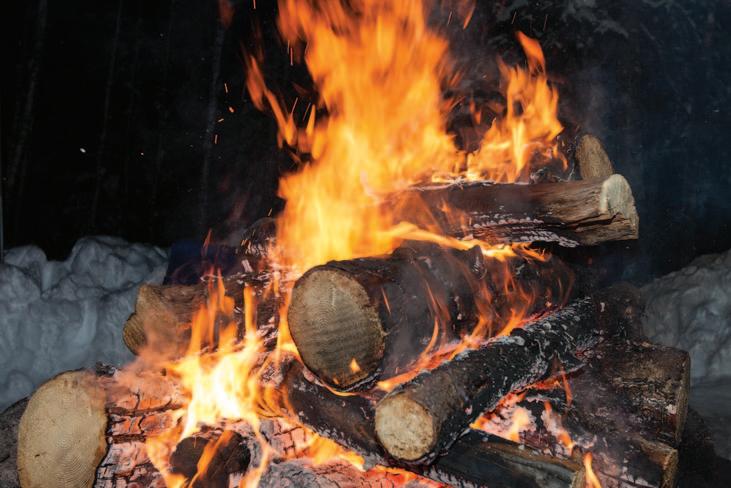
Whether it’s a cozy campfire, a glowing fireplace, or the conflagration of a building or whole forest, we humans respond with a riveted stare. The hypnotic grip on our attention created by the rapid combustion of dead vegetation must be buried deep in our cells, requiring a conscious effort to turn away. Fire can be friend or foe, but during an Ely winter, fire is most often a welcome source of heat and light, just as it was for the Neanderthal braising a bit of mammoth meat for dinner.
Although making and gazing at a campfire may be the same as the experience of our long-ago ancestors, our methods of extracting heat from wood in our homes has changed drastically. Chainsaws and logging trucks, furnaces and fireplaces, chimneys and duct work have become part of the process. Add thermostats, blowers, baffles, and draft devices, and we have a technology that requires a
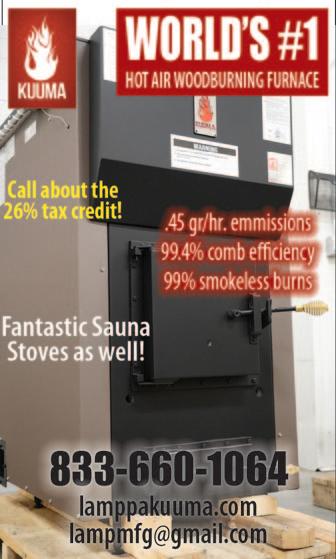
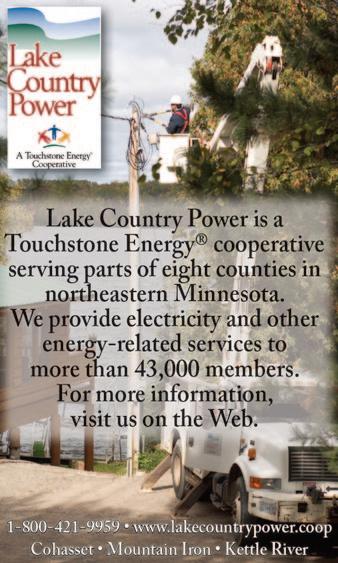
lot more knowledge than simply how to start a fire. Fortunately, there have been engineers and manufacturers dedicated to creating fuel-efficient systems we can purchase without a PhD—just a bit of research. But it’s still helpful to have some knowledge of the local situation here in the north woods—what wood is good; how to buy or harvest and store a winter’s supply; some hardware choices for turning wood into heat.
Ask any Elyite what kind of trees make the best firewood, and you’ll get some consistent replies accompanied by various levels of passion about certain species. Birch is probably the most common first choice. It’s abundant here, burns fairly hot, carries coals an acceptable amount of time, and has the additional benefit of bark that makes fire-starting easy even for beginners. Birch needs to be split in order to dry, though, as that incendiary bark holds the tree’s moisture tightly inside, allowing the wood to rot.
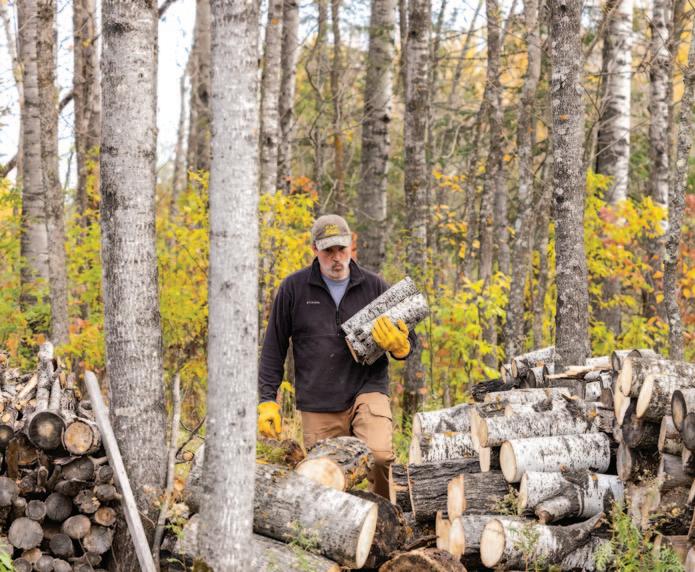

Ash might be next, and is highly favored by those who split their own wood. It is similar to birch in heat released and lingering coals, but it is less abundant and may cost more. Ash is the most straight-grained knot-free tree, which makes splitting easy, and small-diameter pieces will dry without splitting. On a cold winter day, the mall-wielding averagely-strong person can turn a big chunk of ash into kindling within minutes. Those who prefer ash will tell you it gives more heat than birch, but the official BTU rating is the same. (BTU? In case this is an unfamiliar term, a British Thermal Unit is the amount of energy required to heat one pound of liquid water by one degree Fahrenheit. In practical terms it gives the home owner a way to compare the amount of heat they’ll get from different fuels.)
Maple is harder to come by in Ely, but more abundant on the North Shore. Splitting it for an average inexperienced person may involve many four-letter words and an increase in ibuprofen consumption, although strong burly folks who’ve split wood their whole lives don’t complain about it. BTUs for silver maple are similar to birch and ash, but sugar maple is hotter. Maple generally has longerlasting coals, making it good for overnight burns.
Those are the common homeheating kinds of wood in Ely, but others have specialized uses. Aspen (or popple as it’s commonly known) is abundant, but doesn’t burn as hot and is often punky. It’s fine for less-thanfrigid times during fall, spring, and the occasional January thaw. Pine and spruce burn hot and fast—great for starting fires and also for those who cook with wood and need to get the oven up to 350 degrees or have a short burst of high heat for frying. Balsam fir burns quickly, but doesn’t produce much heat. There isn’t enough oak in the area to consider as a winter’s supply, but it has more BTUs than any of our local woods and has excellent coals–in case a load from someplace farther south is available. Firewood can be purchased in the Ely area by the logging-truck, dump-truck, or pick-up load, priced by the cord. A cord of wood is 8 feet long by four feet high and four feet wide, which equals 128 cubic feet.
That is sometimes referred to as a
“logger’s cord” to differentiate it from a “face cord”, which has a
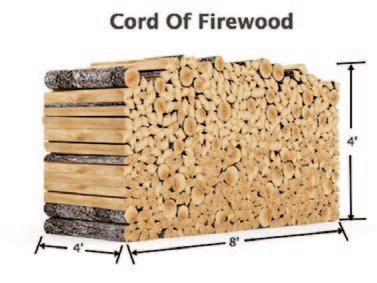
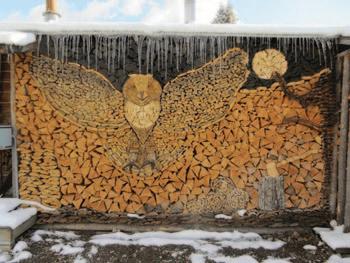
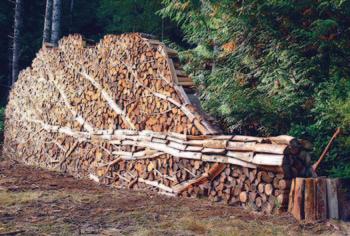
In case you need some inspiration for your wood stacking project; these are widely circulated online, not from Ely.
width that’s only the length to which it has been cut—usually the length that will fit in a stove, around 16”—and so considerably less than a “real” cord. Ely’s professional wood suppliers are reputable, hard-working people who won’t fool the unwary buyer, but it doesn’t hurt to be aware of this difference. Face cords are more often sold in urban areas for fireplace use and may cost even more than a logger’s cord in Ely.
“You get warm when you cut it; you get warm when you split it; you get warm when you haul it; and you get warm when you burn it. You get a lot more warmth from wood than from fuel oil or propane.”
Free time, finances, and fitness (maybe chainsaw experience too) determine whether the home owners who heat with wood harvest their own, purchase full-length logs, or opt for cut-and-split delivery. Either way, once it’s in the yard there is the chore of stacking. This can be fun! A team can become efficient and enjoy the energy they generate doing the physical work, and a single individual can enjoy having control over the process and seeing the progress made after an hour or a day. Different methods exist – bark up or down, in a shed or in the open, rows or piles. The goal is to let the wood “season,” by which is meant get enough moisture out that when it burns, the wood’s energy is used to generate heat, not evaporate water that’s held in the wood. Generally most people prefer bark up and some kind of cover to keep rain off but let moisture escape. Access to sun and breeze is helpful to the process.
How long does this take? How dry is dry enough? It’s a common opinion that wood can’t be too dry, but that’s not always the case. For most wood cook stoves, the drier the better. But for heating a home, wood that’s too dry won’t hold over long hours as well, giving a flash of intense heat for an hour or two instead of a slow steady 8hour burn that provides for a good night’s sleep and a warm house after a day away at work. At least one summer is an accepted practice, but so much depends on the kind of wood, how dry it was to start with, the size of the pieces, and the location of the wood pile. Experience is the best teacher here. A wood moisture meter is a useful tool for determining the
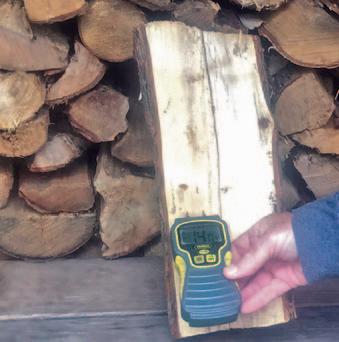

percentage of moisture in wood, and so learning the best amount for the situation. For long steady burns, about 20% is recommended by Lamppa Manufacturing, the Tower-based company recognized world-wide for their expertise in wood heat. More about their furnaces coming up…
At last, dusk is coming early and nights are chilly. Snowflakes have been seen and warm jackets are hanging in the entry way. It’s time to move from splitting and stacking to burning. Here the choices become harder. Unlike the Neanderthal family’s cave, modern homes don’t do well with a fire started on the living room floor and smoke exiting a hole in the roof. There’s that old wood stove your Dad had that’s in great shape even after 50 years of heating the shack. The price is right, but not the real cost—inefficient use of the wood you worked so hard to procure, unacceptable (and possibly illegal) impacts to air quality in your
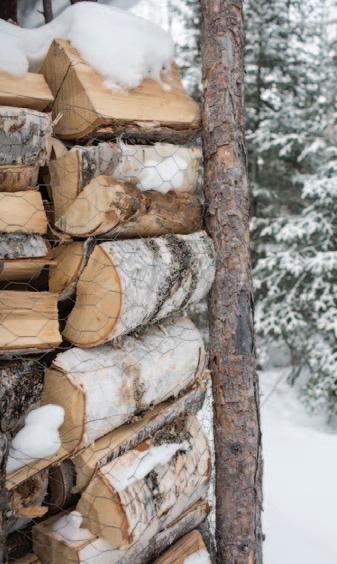


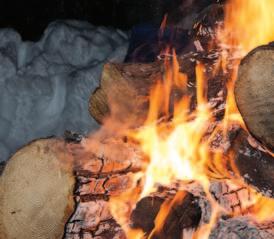
neighborhood, cold floors and hot ceilings, and inconvenient re-fueling times. Plus your home insurance won’t cover any damage resulting from use of a stove that doesn’t have an official (UL) stamp of approval.
For a fireplace type stove there are many choices that vary in price and quality. These are primarily used to supplement another heating system or heat a cabin, garage, or other small area. Visiting stores that sell them can overwhelm the would-be woodstove owner with details about baffles, catalytics, reburn, EPA regulations and more. It’s best to be educated by a source that is not also trying to make a sale, so do some homework ahead. Know the area you want to heat, whether you want a flat top that will take a cast iron pot for cooking or a cauldron for hot water. Is this strictly utilitarian or do you want the aesthetic quality of a glass door and soapstone finish?
Consider the chimney–a critical part of any wood-burning operation, and not inexpensive. In addition to preventing a house fire, the chimney is essential to creating the right draft for your stove. This is not a place to cut costs. Have an expert check your existing chimney if you plan to use it. If it’s old, restoring it to safe efficient functioning is not a weekend DIY job. Think ahead to how you’ll clean it. With new high-efficiency stoves that may not need to happen often, but it does need to be taken into account. If you’ll be installing new stovepipe, Class A1 stainless steel is recommended, and BTU for Wood found in the Ely Area or nearby
Wood Heat per cord in million BTUs
Alder
17.5 Apple 27.9 Ash, black 19.1 Aspen (popple) 18.2 Balsam Fir 14.3 Basswood 13.8 Birch, white 20.2 Birch, yellow 21.8 Boxelder 18.3 Cedar 12.2 Cottonwood 15.8 Elm, American 20.0 Maple, red 18.6 Maple, silver 17.0 Maple, sugar 24.0 Oak, bur 26.2 Oak, red 24.6 Oak, white 26.4 Pine, jack 17.1 Pine, red 17.1 Pine, white 14.3 Spruce 15.5 Willow 17.6
avoid any angles greater than 45 degrees–the stovepipe should not run horizontally. A chimney cap is important to keep critters, rain, and snow out. Speaking of safety, don’t forget to check your smoke and carbon monoxide detectors before heating season gets underway whatever fuel you are using.
This is an excellent time to install or refurbish your wood-burning heat source to increase energy efficiency and decrease air pollution. If you can make the purchase before Dec 31, 2022, federal programs will give you 26% of your costs back with no cap on the amount. Starting in 2023 and going for 10 years, you can get 30% back with a $2,000 limit per year. This applies to other improvements as well, including solar and wind electricity.
Lamppa Manufacturing is a company based in Tower, MN–just down the road from Ely. Always a small, family-run business, they started in the early 1900s. In the 1970s, Darryl Lamppa was determined to make a stove that was more efficient. What resulted was a wood furnace that was years ahead of its time, exceeding what in 2020 became strict EPA regulations on emissions. No other cordwood-burning system in the world has ever surpassed their emission and efficiency numbers. For the past 40+ years, Lamppa Manufacturing has produced the most efficient, least polluting stoves on the planet! And they are constructed with American-made steel.
The Lamppa Kuuma (Finnish for hot) Vapor-Fire 100 wood-burning furnace works with a forced-air duct system to heat up to about a 4,000 square foot building. This furnace is designed to provide consistent heat over a 12-hour period. The company works closely with buyers to ensure installation is ideal. About 20% of new purchases are installed by the home owner, with the other 80% split evenly between hiring a commercial HVAC company and using a local handyperson. For anyone building a new home, installing the system during construction is obviously the best choice, and a back-up such as in-floor heat can be added for times like vacation when firing up the wood furnace isn’t practical.
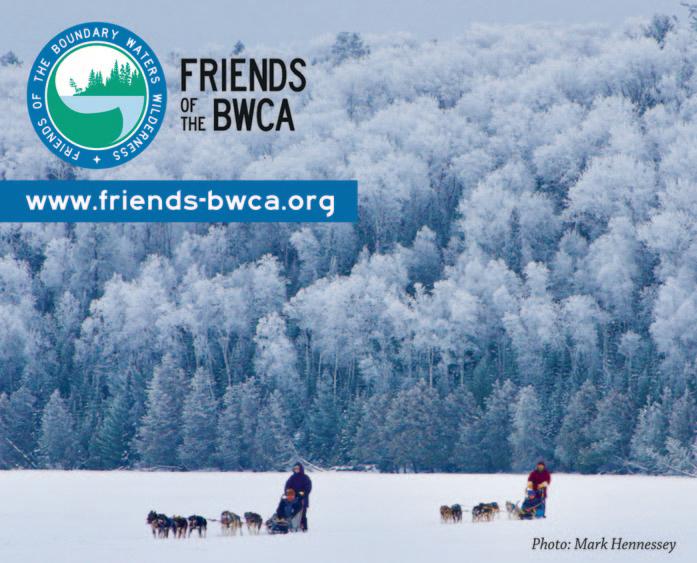
Lamppa also makes efficient, clean-burning wood sauna stoves. These are designed to provide fast heat–not quite the burn times of the furnace, but far superior to most sauna stoves. There are three sizes, any of which can be fitted with a glass window for fire-gazing. A hot water tank can be added. Like the furnace, Kuuma sauna stoves are made with heavy-duty U.S. stainless steel to provide a lifetime of sauna relaxation.
The Lamppa story is fun reading, especially if you are intrigued by Finnish culture, and even if you’re not in the market for a furnace. You can find their history (starting in the early 1900s) along with helpful videos, enticing photos of their products, pricing, and detailed technical specifications at their website–LamppaKuuma.com.
Kuuma Sauna Stove

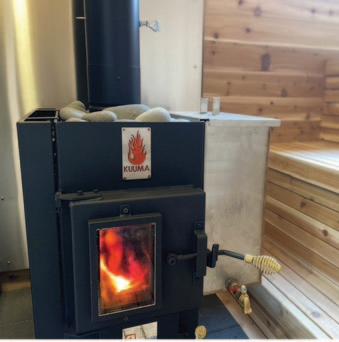
© Lamppa Manufacturing










